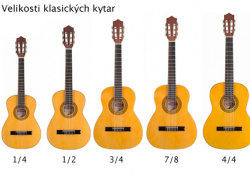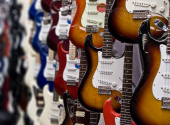
Which Acoustic Guitar Is Better: Classical or Western?
Do you want to learn to play guitar but don't know which one to choose? Do you want to know how a "classical" or "Spanish" nylon-string guitar differs from a "western" steel-string acoustic guitar and what the advantages of each type are? In this article, we'll give you the lowdown.
Classical or "Spanish" nylon-string guitar
Any beginner will notice this basic difference: nylon strings are used on a classical guitar, whereas western acoustic guitars have steel strings. Of course, there are also differences in construction, neck parameters, body size and so on, leading to the main resulting difference—the sound of the instrument itself.
Let's start with the classical guitar, which, after all, originated a century earlier. The classical guitar was originally designed for playing classical music, but over the last seventy years it has expanded into many areas of popular music such as folk, country, jazz, and other areas where fingerpicking is used. Different types of instruments derived from classical guitars are used in folk or traditional Spanish music, as its colloquial name "Spanish guitar" suggest. In addition to the use of nylon strings, classical guitars are distinguished by a flat fingerboard, a wider neck, and usually a longer scale length (the distance from the zero fret to the bridge).
Classical guitars, unlike steel-string acoustic guitars, are mostly made in a uniform shape, with a wide fingerboard (about 53 mm) suitable for larger fingers, and with nylon strings, which are soft and do not cut the beginner's fingers as much as steel strings do. In addition, classical guitars come in five sizes to suit the age and disposition of the player, so even a young child can start playing classical guitar. Classical guitar sizes are given in fractions, so starting with the smallest version, the children's guitars are 1/4, 1/2, 3/4, 7/8, and finally the adult version is 4/4.
The classical guitar is suitable for beginners who have not played any stringed instrument before and are learning their first chords, fingering, and playing with a plectrum/pick. It must be said, however, that its sound does not stand out as much in the noisier environment of a campfire, for example. Due to the different string tension, you shouldn't put steel strings on a classical guitar, as they would deform and damage it. So if you crave the tinkling tone of steel strings, read on.
Acoustic or "western" steel-string acoustic guitar
Acoustic steel-string or western guitars is a collective term for a group of guitars that combine the use of steel strings, a narrower neck, and a rounded fingerboard. They are suitable for folk, bluegrass, country, blues, pop, rock, and other genres, and are most often played with a pick, although there are also several styles of fingerpicking. As for the construction and shape of the acoustic steel-string guitar: due to the greater pull of the steel strings on the bridge, the soundboard is reinforced from underneath with cross ribs, unlike a classical guitar; and the strings themselves do not wind directly behind the bridge, but are wired through the bridge and soundboard with pegs, which you'll appreciate especially when changing strings.
Steel strings have a stronger sound, but are harder to pluck than nylon strings. It should be noted that this unpleasant property can be partially eliminated by using thinner strings, which sound less powerful but are softer to the touch—these are steel strings marked 9 or 10 (this number indicates the thickness or "gauge" of the thinnest E1 string in hundredths of an inch).
Shapes of acoustic steel-string guitars
The different types of western guitars are united by the use of steel strings and similar technical parameters and construction. They are distinguished by the shape of the body, which influences the final sound of the instrument.
- Small guitars Parlor, Folk, Mini Jumbo
- Standard Dreadnought
- Large guitars Jumbo, Grand Auditory, Grand Symphony, Grand Orchestra, Grand Concert
The basic shape is the dreadnought, the name given to a type of guitar developed by C. F. Martin in 1916. It is probably the most widely used and popular version of the acoustic guitar, with the advantage of versatility and convenience. As a result, it is used by guitarists in most musical genres. The Jumbo is characterized by its larger and rounder body, which makes it louder and better at delivering bass tones. So you basically can't go wrong by choosing a dreadnought or jumbo. It's a comfortable acoustic guitar for beginners (and not only for them, of course).
Choosing between the other types of acoustic guitars may be recommended for more advanced guitarists who have a more precise idea of what they require from the instrument. Grand Concert label guitars have a smaller, more comfortable body with a harmonically rich sound that you will appreciate not only when playing with your fingers. The Grand Auditorium then offers a slightly larger body, its sound is more colourful, more powerful, but still very clear. You can also encounter Parlors, which are smaller guitars with a very small body used in folk and blues. Some manufacturers market their own types of instruments, which then carry their own labels.
A separate chapter is western or classical guitars with a cutaway in the lower part of the body below the fingerboard, which allows soloists better access to the last frets of the fingerboard. This is mostly found on electroacoustic guitars, which we'll talk about later.
Materials
- laminate or plywood guitars
- solid wood guitars
- semi-solid wood guitars
Another measure of a guitar's quality is the material from which it is made. Both types of guitars—western and classical—can generally be said to be made of either plywood, semi-solid wood, or solid wood.
The advantage with western guitars is that there are relatively few factors to consider when making a choice. What is important, however, are the materials used: you need to distinguish between plywood guitars (where the sides, front and back are made of laminate wood), semi-solid guitars (the sides are laminate, the top is solid, the back can be solid or laminate) and all-solid guitars (everything is solid wood).
Plywood guitars
The cheapest are plywood guitars, which have the advantage of a more or less constant sound throughout their lifetime. The sides, top, and back are made of laminate wood, which affects the sound of the instrument. If you like to take your guitar on camping trips or if you live in a basement, plywood is a good choice—that's because these guitars are significantly less susceptible to changes in temperature or humidity.
Semi-solid wood guitars
If you are looking for a compromise between quality and price, a semi-solid wood guitar is the right choice for you. Fortunately, these instruments are becoming more and more affordable. Semi-solid wood guitars also have a plywood body (the back can be solid or laminate), but the soundboard is a single piece of solid wood, which significantly improves the sound quality: it's stronger, brighter, and more resonant.
Solid wood guitars
If you are looking for a truly first-class instrument, choose an solid wood guitar, whose construction consists of slabs taken from a single piece of wood. These guitars have the best and cleanest sound of all three categories.
Type of wood used
The type of wood from which the guitar is made (also referred to as "tone wood") is another important component that determines its final sound. Commonly used woods include spruce, mahogany, rosewood, cedar, maple, oak, acacia, wild cherry, but also other good sounding exotic woods such as koa, bubinga, zebrawood, nato and others. A combination of these woods, where one is used for the soundboard, another for the sides and back, and yet another for the neck, results in guitars with a unique, multifaceted and multicolored sound. It's impossible to say what the best combination is, because what "sounds good" will be different for everyone as it depends on personal preference and taste. Traditional combinations include spruce and mahogany, cedar and rosewood, spruce and rosewood, cedar and cherry, and more.
Semi-acoustic (or electro-acoustic) guitar
Western and classical guitars, unlike electric guitars, work purely on the principle of natural amplification of sound resonating in the body of the instrument. Sometimes, however, it is necessary to make the sound even louder or to work with it further—for example, when playing in a band or recording. For this, the sound needs to be captured and converted into an electrical signal.
If you buy a purely acoustic guitar, then you have two options: retrofit a pickup system, which may not be the optimal solution, or use a microphone. Sound capture with a microphone is the best option in a recording studio, but it may not be entirely appropriate when playing live—the player's movements are limited as they need to stay in one place with the instrument (unless a sensitive condensor mic is used, as in the "single mic" traditional bluegrass style), plus some other complications may arise.
So if you want to play with a band, it may be advisable to consider buying a semi-acoustic guitar. Such an instrument is equipped with a pickup and usually a preamp. Most often piezoelectric pickups are used, less often contact microphones, and you will also meet electromagnetic pickups. You can plug a jack-jack cable into an electroacoustic guitar and run the signal through a guitar combo and a DI box to a mixing console, for example. The electronics of these guitars can also include a tuner. "Active" pickup systems require a 9V battery power supply, "passive" pickup systems get their power from an external preamp. Otherwise, a semi-acoustic guitar has the same hollow body as a regular acoustic guitar and will still sound without being plugged into an amplifier.
12-string guitar
Although this type of guitar is less common, it is quite widely used. You can find "twelve-strings" in folk music as well as in rock music. Guitarists often choose them because of their fuller and more colorful sound, which is particularly useful when playing accompaniments. The E, A, D, and G strings on 12-string guitars are usually accompanied by a string an octave higher, while the B and E strings are doubled. Because of this, some technical parameters had to be adapted, so that, for example, the neck is wider on these guitars. For a guitarist who is not used to this type of instrument, playing a 12-string guitar can be a more difficult affair at first, but mastering it is certainly worthwhile. However, it is definitely not an instrument for absolute beginners.
Accessories
When buying a guitar, it's always a good idea to buy a spare set of strings. Respect the type that the instrument requires: buy nylon strings for a classical guitar, steel strings for a western guitar. For beginners, it is advisable to buy thinner strings to start with.
Also, you will need to tune the guitar, so you will appreciate a tuner. You can choose between "handheld" tuners, which pick up the sound with a microphone, and clip-on tuners, which you clip on to the instrument so they pick up its vibrations. There are tuners designed exclusively for guitars and their standard tunings, but more suitable are chromatic tuners, which can tune any instrument in any tuning. Some tuners may have other features built in, such as a metronome.
It is certainly a good idea to have a case for carrying and transporting your guitar. If you carry your instrument often and don't need extreme mechanical protection, a soft case aka gigbag will do the trick. If you need more protection and don't mind the weight and size, choose a hard case.
You'll probably want to get some picks as well. Unfortunately, it's impossible to advise exactly what kind, as this really depends on personal preference.
If you want to play standing up, you'll need a strap, which is made of nylon or leather.
You might also appreciate some guitar cosmetics to help keep your instrument in perfect condition.
And if you don't want your guitar to be knocked over and break, don't forget about a reliable stand that you can place your guitar in whenever you're not playing it, be it at home or on stage.
To close
So which guitar to choose to start with? Let's review the basic differences:
- A classical guitar has a wide fingerboard, softer nylon strings, a weaker sound, and all models are the same shape in the five sizes.
- A western guitar has a narrow fingerboard, harder metal strings, a stronger sound, and there are several sizes and shapes to choose from.
So it's entirely up to the novice player to decide what type of guitar to choose for their first introduction to the world of music. There are many options and fortunately there is not only one right choice...
When choosing a guitar, however, it pays to think about the genre of music you intend to use it for and the demands you're making on it. In addition to the type of instrument and its price, the materials from which the guitar is made, its equipment and the level of workmanship are also important criteria.
If you have found an error or typo in the article, please let us know by e-mail info@insounder.org.





